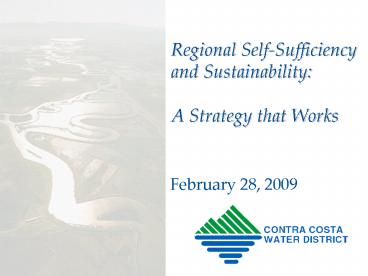Regional SelfSufficiency and Sustainability: A Strategy that Works - PowerPoint PPT Presentation
1 / 13
Title:
Regional SelfSufficiency and Sustainability: A Strategy that Works
Description:
Multiple wins with conservation 'Follow the water, the energy and the money' Conservation (reducing consumed water) reduces water use and: ... – PowerPoint PPT presentation
Number of Views:47
Avg rating:3.0/5.0
Title: Regional SelfSufficiency and Sustainability: A Strategy that Works
1
Regional Self-Sufficiency and SustainabilityA
Strategy that Works
- February 28, 2009
2
Moving to Regional Self-Sufficiency
- Past accomplishments are admirable, but they are
not the future - Water use efficiency local responsibility,
global benefits - Multiple wins water conservation reduces
- Energy use
- Wastewater treatment
- Green house gases
- Costs (savings for customers)
- And, makes water available for other uses
3
Past Accomplishments are Admirablebut not the
Future
- Southern California
- Significant accomplishments
- Water use is similar to that of 30 years ago
despite population growth - Bay Area
- Population increase of 17 since 1988
- Water use is essentially the same
4
Contra Costa Water District
- 1988-1990 Average use was 140,000 acre-feet per
year - Current use is about 115,000 af/year
- Population has increased 40 since 1988
5
How was that done?
- Reduced unaccounted for water with meter
replacements - Industry closures, with recycled water for new
industries - Focus on efficient outdoor use
- Nonetheless, that is not all that can be done
- CCWD supports the 20 by 2020 goal
6
Local Responsibility, Global Benefits
- Small improvements multiplied by hundreds of
thousands of homes generates real benefits - Local savings can provide
- Better water quality in the Delta
- More reliable supplies for all
- A more stable water system
7
Not all savings are equal though
- Northern California dilemma
- Do water savings translate to more water? For
whom? - What are the benefits and tradeoffs?
- Example recycling water that is otherwise
discharged to the Delta - Already recycled
- May not reduce pollutant load
- Expensive and energy intensive
- May still work, but needs honest evaluation
8
Multiple wins with conservation
- Follow the water, the energy and the money
- Conservation (reducing consumed water) reduces
water use and - Energy consumption (pumping and treatment)
- Chemical production and transport
9
Multiple wins with conservation
- Follow the water, energy and money
- Conservation (reducing consumed water) reduces
- Consumer energy use (heating water for in home
use) - Wastewater treatment, chemicals and pumping
10
Multiple wins with conservation
- Follow the water, energy and money
- Conservation (reducing consumed water) saves
energy and that reduces - Greenhouse gas production
- Costs (water pumping, treatment, consumer
energy, wastewater treatment and pumping)
11
Finally, with all that has been done
- How does an urban agency reduce consumption 20
by 2020 - New development sustainable water systems
(landscaping, small scale recycling, water
budget, dual plumbing) - Grey water projects and local catchments
- Improved conservation at all levels
- Recycling where it works
12
Finally, with all that has been done
- Other necessary infrastructure
- Storage we still have a drought every year
(starts in the spring, ends when is starts
raining again) storage needed for dry periods - Desalination Very promising.and probably
always will be (energy intensive) - Dual plumbing (the most expensive part of
recycling)
13
What challenges remain?
- Demand hardening
- With high efficiency, there is less opportunity
to reduce during shortages (cant put a brick in
an ultra low flush toilet!) - Need to store some of the water saved (saving
for a non-rainy day)! - Inter-agency agreements to better use existing
infrastructure, partnerships to reduce risks

